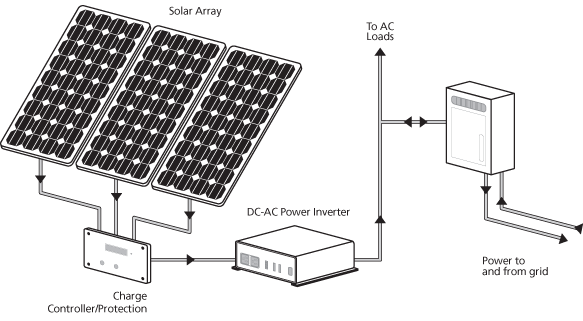Simple Steps to Going Solar
1) Home Energy Assessment
2) Decide on a System
3) Secure Financing
4) Engineering & Permitting
5) Construction
6) Utility Makes Connection
Begin with a Home Energy Assessment
The energy assessment analyzes your home’s orientation to the sun as well as the amount of electricity your home uses throughout the year. This tells us how many panels your home needs and where they should be placed to get the most sun and meet your home’s energy needs.
Decide on the best system for your home
Most homes have enough roof space to meet their energy needs, but some home have little space for solar due to tree shade or multiple dormers breaking up the roof line. In that case, a ground mount may be your best option. Another solution would be to install an elevated ground mount so you can park your car under the shade of the panels. Whatever your needs are APG is here to answer your questions and provide solutions.
Secure Financing
We have secured several options for you to finance your solar systems. We are partnered with local banks and financing programs to provide you with a low rate unsecured green home improvement loan.
Engineering & Permitting
APG Solar completes all the engineering and permit paperwork that the cities and counties require for construction. We avoid delays by hand delivering plans and permits for your home solar project. We also communicate with the utility company so you have the smoothest transition to solar.
Construction
We complete all installations with our own install team. We take pride in a good looking installation and we leave your home and property clean when we are finished. After construction, the local jurisdiction will send a representative out to finalize the permit and record that construction is complete.
Utility Interconnection
The final step is when your electric company approves and initiates the connection between your home and the electricity grid. This step is called Permission to Operate, or PTO.
Solar FAQ
Answers to All your Questions
Economics & Incentives
Federal Incentives The Energy Act of 2005 passed by the U.S. Congress provides homeowners a federal tax credit equal to 30% of the contract cost of a residential solar electric or solar domestic hot water system. This Investment Tax Credit (ITC) is set to begin decreasing after 2019 and will expire for residential installations after 2021.
An accelerated corporate depreciation schedule is allowable for solar photovoltaic systems – for more information please refer to Internal Revenue Service Tax code Section 149, Publication 946 and Internal Revenue Service Form 4562 addressing Depreciation and Amortization.
State Property Tax Exemption The California Revenue and Taxation Code section 73 provides a property tax exemption for Photovoltaic solar energy systems installed. Qualifying solar energy systems are defined as those that “are thermally isolated from living space or any other area where the energy is used, to provide for the collection, storage, or distribution of solar energy.” Please note a current list of state and local programs is available at The Database of State Incentives for Renewable Energy.
Increased Home Value One study has indicated that for every $1,000 reduction in annual operating costs from energy efficiency, a home’s value is increased by $20,000. Other independent studies attach a more conservative value. Our software analysis tool, assigns in most cases the increased value is the same as the original system installation price.
Hedge Against Rising Electricity Prices Once you have invested in your system, you will be co-generating power with the utility grid. You will then be less susceptible to increases in energy costs on the power you purchase for the life of your system. Electricity rates have historically increased by approximately 6% on average each year for the past 30 years.
Other State Programs and Incentives : Incentives are fully dispersed and are now expired. The California Public Utility Commission (CPUC) approved the California Solar Initiative (CSI) on January 12, 2006. The CSI was a $2.167 billion program that provided incentives for solar development over an 11 year time frame.
Benefits Of Solar Energy
Environment – Zero Emissions! Solar power produces no emissions unlike much of today’s utility-supplied power. Once the system has paid for itself, which only takes a matter of years, decades of clean sustainable power will be enjoyed at no charge!
For every megawatt hour of solar electricity produced the Earth is spared the pollutants of over 1500 pounds of greenhouse gases like CO2, SO2, and NOx. Based on a small residential solar powered system (2.5kW PTC), that works out to almost 3 tons of greenhouse gas avoidance per year, or 75 tons over 25 years. Solar power is clean, abundant and fully renewable. It has been scientifically concluded that solar energy if captured completely for 1 hour could provide the world’s energy needs for 1 year.
Economic Benefits – Because solar power reduces our dependence on the Utility companies it also reduces the need to build new conventional peaking power plants. There is approximately 5000 megawatts of energy potential currently available by utilizing the space on existing roofs of homes and small businesses in California. Turning even a small percentage of that potential into solar power generation would reduce or eliminate our need to build new power plants for many years to come.
Complementary to Utility Power – Solar power correlates well with the daily load patterns of utilities because the power is available when it is needed most – during daylight hours when utilities are subject to their peak loads and more specifically late morning to early evening in summer months during high air conditioning loads.
Low Operating Cost – Once installed, photovoltaic cells operate continuously for decades with few ongoing operating costs. They generate electricity through a wide range of temperature and light conditions.
Reliable – With no moving parts and a warranted life for PV panels of 20 to 25 years, solar PV systems are highly reliable and require little routine maintenance.
How Does Solar Work?
Active Electricity Production Solar Photovoltaic (PV) technology has come a long way. Early PV was utilized to power digital calculators. PV systems can now be found on many homes and businesses.
A PV Solar Panel takes the suns radiation and processes it through a semiconductor to produce a Direct Current (DC) electrical charge. This can be used immediately, or you can utilize batteries to store it for later use. To power your home, the DC current (either stored or produced) is inverted into standard AC current.
This is done by utilizing two power inverters which are set to simulate Alternating Current patterns. The power then enters your Service Panel through the service disconnect and is either used by electrical appliances and lights in your home, or it is returned back to the utility’s electrical grid to power someone else’s home. When it is returned to the grid, you receive a credit on your electric meter.
Passive Water Heating (Solar Thermal) & Cooling Solar Water Heating – The sun’s heat is absorbed through a solar heat collector and runs through a “heat transfer system” to create hot water. It can be used immediately or sent to storage for later use. This type of solar energy is most efficient during the day. The water can be used to heat a house, such as radiant floors (piping under the flooring to keep the floors warm). It can also run a heat exchanging system to cool your house (like a refrigerator).
More Solar Questions
How do I compare prices among different solar contractor bids?
Comparing apples to apples with solar starts with the price per DC watt (your total contract price divided by the DC array size). Product is the second factor to consider. Insist on ARRA (American Recovery and Reinvestment Act) components (panels and inverters). Beware of products coming from brands that may not stand behind their warranties. Thirdly look at the company history and customer reviews. Be sure they have a solid business model that you can trust will be around to fulfill their warranty.
Is my roof right for solar?
A solar power system can be installed on most roof types; the most limiting factor is shade. South facing roofs offer the most annual production, while east and north will produce much less energy. However, west-facing roofs produce more power during “peak" times when power can be more expensive. This is important for utility customers who can take advantage of time-of-use metering (PG&E customers). APG Solar suggests that customers with older roofs consider replacement prior to installing solar panels. Call our office to ask for a roofer reference.
Can my roof support the weight of the solar array?
Solar panel and mounting equipment add very little weight to your roof. In most cases the solar power system will add an additional 3 lbs. per sq. ft. of weight to the roof. Modern construction (built after 1970) is designed and permitted to support loads far greater than this.
Are there special loans for installing residential & commercial solar power?
Yes! Contact your solar consultant or our office for the most recent list of lenders: Lenders List
Is solar electricity really a good investment?
Your solar electric system will protect you against annual increases from your utility company as well as provide for ownership of your electric generation. Our solar consultants can assess your specific needs, calculate exactly what your return on the investment will be, and estimate the amount you will save over the life of the system.
Is utility power really cost-effective?
Yes! Utility rates are constantly increasing, and have increased on an average of 6% annually during the last 30 years. They also have the option to manipulate the tiers and monthly fees. Solar creates security and stability in your cost per watt of generated and consumed energy. In addition to charging for watts consumed, the utility also charges for electricity transmission, surtax fees, special payment programs, and others. As you pay your utility bill you do not gain equity in an asset. Paying for utility power is the equivalent to renting your home instead of purchasing it.
How long until my system realizes net savings?
It is possible to experience savings the month after your system is online if you take out a loan. How? Instead of paying your monthly utility bill, you will make monthly loan payments for your PV system, this loan payment could be equal to or less than your average monthly utility bill before solar. If you pay cash for the system, you will generally see a payback period between 4 – 11 years. Factors that determine your exact payback include your pre-solar electrical usage, the current electric rate schedule, the solar location and performance, and the cost of your system (if including other electrical upgrades or special structures the payback is longer). In general, the larger your electric bill the greater the return on investment and the faster the payback.
How does solar electricity benefit Utility Providers, our Government, and the environment?
Your system will reduce the demand on existing fossil-fuel power plants and their distribution networks. It will reduce dependence on foreign oil, and reduce pollutants and global-warming emissions (a 3 kW PV system will eliminate approximately 7,000 pounds of annual CO2 that would have been emitted had the electricity been generated conventionally).
How much does a solar electric system add to the value of my property?
According to a study conducted by the Lawrence Berkeley National Laboratory of California home sales, “the analysis finds strong evidence that California homes with PV systems have sold for a premium over comparable homes without PV Systems." The bottom line of the study was that the investment in solar, appears to be comparable to the increased property values at time of sale. Even better news is that as of right now, the value of your solar system is excluded from property tax assessments for existing property owners due to Proposition 7 (1980).
Will my property tax base increase?
Despite the fact that your property value will increase, there is legislation that prevents your property taxes from increasing from installing solar components. In Nov of 1980, the people passed Proposition 7 which redefined solar energy systems. No longer were they considered “newly constructed" for the purposes of property taxes. California Revenue and Taxation code codified this change in section 73.
Can I really offset my loads & eliminate my monthly utility bill with a properly designed/installed solar energy generation system?
Yes! Provided you have enough physical space (roof or ground mount) for a full load array design, proper orientation, good performance, & sunshine you can own a photovoltaic system that will produce as much electricity as you use. However, you should expect to see a monthly connection charge from the utility.
Why should I borrow money to pay for solar?
You must pay a monthly utility bill for energy. You are already essentially financing an indefinite, variable rate loan from your utility company. Installing a solar power system allows you to refinance this loan at a fixed rate and term, pay less every month, and have your loan payments go towards ownership of a valuable asset, and own your energy generating system at the end of the term.
Will the utility company really pay me for my solar electricity?
Yes, as of January, 2011. However, they will purchase power from you at the wholesale rate. As a result, it is recommended to design your system to meet your current electricity needs and not more.
What happens to the solar electricity that I do not use?
Any excess solar electricity produced will go back into the utility grid through your meter, running it backwards. You are credited for each kWh produced at the same rate that you would be charged.
How will my PV system perform on a cloudy day or at night?
Your solar electric system will still produce electricity, however at a reduced level based on the amount of ambient light it receives. During the nighttime, there will be no production.
Will my solar electric system provide heating?
No, there are two types of “solar” collectors, electric and thermal. Electric systems are only hooked up to the electrical panel (breaker box) in your home. APG Solar does also install solar thermal heating systems for both pools and domestic hot water needs.
Do I need a conventional generator?
You do not need a generator if you are installing a solar electric system. A generator can be integrated to work with solar to power your house as a backup energy provider in the event the grid goes down. APG offers all major brand generators in various sizes and fuel requirements for your generator needs.
What loads or appliances can I power with my solar electric generation system?
All appliances and loads receiving power from your metered load center will enjoy the benefit of your solar electric generation system.
Do I need batteries with my installation?
There is no need for batteries when you are connected to the local electric utility supplier. The utility grid serves as your battery bank. When your home needs more power than your solar system is generating, or when you need power at night, the utility grid provides the power and runs your meter through the credits that you created during the times you created more electricity than you were using. In the event you do not have access to the local utility then you will need a bank of batteries.
What are the major components of a solar electric system?
Major components will be solar panels, sometimes referred to as modules, and the inverter. The rest of the components sometimes referred to as BOS (balance of system) are racking, overcurrent protection, conduit, and wiring.
How does solar electricity work?
Photovoltaic electricity, or light energy from the sun, is transformed into electricity within silicon semiconductor cells. These cells are placed most commonly on substrate within a framed aluminum enclosure covered with a low iron tempered glass lens, creating a solar panel. The type/quality of the cells and the wiring configuration will determine the DC voltage and current output. The output of these panels are wired to an inverter which changes the DC voltage and current to AC which can now be connected to your metered load center and used in your home.
Are there any tax incentives?
Yes! Homeowners may claim 30% of the contract price as a Federal Income Tax credit. This amount begins to decrease after 2019 and is set to expire after 2021. Commercial customers can take that same credit. Commercial customers may also depreciate additional amounts in compliance with Section 179 in the United States Internal Revenue Code. To read more about the current Solar Investment Tax Credit visit the Solar Energy Industries Association page.






